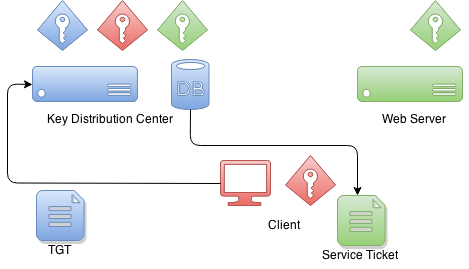附录
附录 A:本文档中使用的材料
示例中使用的虚拟 UserDetailsService,因为我们没有真实的用户源。
public class DummyUserDetailsService implements UserDetailsService {
@Override
public UserDetails loadUserByUsername(String username)
throws UsernameNotFoundException {
return new User(username, "notUsed", true, true, true, true,
AuthorityUtils.createAuthorityList("ROLE_USER"));
}
}附录 B:Kerberos 速成课
在任何认证过程中,通常涉及三方。

首先是 client(客户端),有时它是一台客户端计算机,但在大多数情况下,它是坐在计算机前试图访问资源的实际用户。然后是用户试图访问的 resource(资源)。在本例中,它是一台 web 服务器。
然后是 Key Distribution Center(密钥分发中心)或 KDC。在 Windows 环境中,它将是 Domain Controller(域控制器)。KDC 是真正将所有事物连接在一起的组件,因此是您环境中最关键的组件。正因为如此,它也被认为是单点故障。
最初设置 Kerberos 环境并将域用户主体创建到数据库中时,也会创建加密密钥。这些加密密钥基于共享秘密(即用户密码),实际密码从不以明文形式保存。实际上,KDC 拥有自己的密钥以及用于域用户的其他密钥。
有趣的是,在认证过程中,resource(资源)和 KDC 之间没有通信。

当客户端希望使用 resource 进行自我认证时,它首先需要与 KDC 通信。Client 将构建一个包含加密和未加密部分的特殊数据包。未加密部分包含用户信息,加密部分包含协议中的其他信息。Client 将使用自己的密钥对数据包数据进行加密。
当 KDC 从客户端接收到此认证数据包时,它会检查未加密部分中的 client 声称是谁,并根据该信息使用其数据库中已有的 client 解密密钥。如果解密成功,KDC 就知道此 client 就是它声称的身份。
KDC 返回给客户端的是一个称为 Ticket Granting Ticket(票据授予票据)的票据,该票据由 KDC 自己的私钥签名。稍后,当 client 将此票据发送回来时,它可以尝试解密它,如果操作成功,它就知道这是 KDC 最初自己签名并提供给 client 的票据。

当客户端想要获取可用于向服务进行认证的票据时,会将 TGT 发送到 KDC,然后 KDC 使用服务自己的密钥签署服务票据。这时,client 和 service 之间建立了信任。此服务票据包含只有 service 本身才能解密的数据。

当 client 向服务进行认证时,它会将之前收到的服务票据发送给服务,然后服务会想:“我对此人一无所知,但他给了我一个认证票据。” 接下来 service 可以尝试解密该票据,如果操作成功,它就知道唯一知道我的凭据的另一方是 KDC,并且由于我信任他,我也可以信任此客户端就是他声称的身份。
附录 C:设置 Kerberos 环境
Kerberos 生产环境的设置超出了本文档的范围,但本附录提供了一些帮助,以便您开始为开发设置所需的组件。
设置 MIT Kerberos
第一步是设置一个新的领域和数据库。
# kdb5_util create -s -r EXAMPLE.ORG
Loading random data
Initializing database '/var/lib/krb5kdc/principal' for realm 'EXAMPLE.ORG',
master key name 'K/[email protected]'
You will be prompted for the database Master Password.
It is important that you NOT FORGET this password.
Enter KDC database master key:
Re-enter KDC database master key to verify:kadmin 命令可用于管理 Kerberos 环境,但您尚不能使用它,因为数据库中没有管理员用户。
root@neo:/etc/krb5kdc# kadmin
Authenticating as principal root/[email protected] with password.
kadmin: Client not found in Kerberos database while initializing
kadmin interface让我们使用 kadmin.local 命令创建一个。
root@neo:/etc/krb5kdc# kadmin.local
Authenticating as principal root/[email protected] with password.
kadmin.local: listprincs
K/[email protected]
kadmin/[email protected]
kadmin/[email protected]
kadmin/[email protected]
krbtgt/[email protected]
kadmin.local: addprinc root/[email protected]
WARNING: no policy specified for root/[email protected]; defaulting to
no policy
Enter password for principal "root/[email protected]":
Re-enter password for principal "root/[email protected]":
Principal "root/[email protected]" created.然后通过修改 kadm5.acl 文件并重新启动 Kerberos 服务来启用管理员。
# cat /etc/krb5kdc/kadm5.acl
# This file Is the access control list for krb5 administration.
*/admin *现在,您可以使用先前创建的 root/admin 主体来使用 kadmin。让我们创建第一个用户 user1。
kadmin: addprinc user1
WARNING: no policy specified for [email protected]; defaulting to no
policy
Enter password for principal "[email protected]":
Re-enter password for principal "[email protected]":
Principal "[email protected]" created.让我们创建第二个用户 user2 并导出 keytab 文件。
kadmin: addprinc user2
WARNING: no policy specified for [email protected]; defaulting to no
policy
Enter password for principal "[email protected]":
Re-enter password for principal "[email protected]":
Principal "[email protected]" created.
kadmin: ktadd -k /tmp/user2.keytab [email protected]
Entry for principal [email protected] with kvno 2, encryption type aes256-cts-hmac-sha1-96 added to keytab WRFILE:/tmp/user2.keytab.
Entry for principal [email protected] with kvno 2, encryption type arcfour-hmac added to keytab WRFILE:/tmp/user2.keytab.
Entry for principal [email protected] with kvno 2, encryption type des3-cbc-sha1 added to keytab WRFILE:/tmp/user2.keytab.
Entry for principal [email protected] with kvno 2, encryption type des-cbc-crc added to keytab WRFILE:/tmp/user2.keytab.让我们为 tomcat 创建服务票据,并将凭据导出到名为 tomcat.keytab 的 keytab 文件。
kadmin: addprinc -randkey HTTP/[email protected]
WARNING: no policy specified for HTTP/[email protected];
defaulting to no policy
Principal "HTTP/[email protected]" created.
kadmin: ktadd -k /tmp/tomcat.keytab HTTP/[email protected]
Entry for principal HTTP/[email protected] with kvno 2, encryption type aes256-cts-hmac-sha1-96 added to keytab WRFILE:/tmp/tomcat2.keytab.
Entry for principal HTTP/[email protected] with kvno 2, encryption type arcfour-hmac added to keytab WRFILE:/tmp/tomcat2.keytab.
Entry for principal HTTP/[email protected] with kvno 2, encryption type des3-cbc-sha1 added to keytab WRFILE:/tmp/tomcat2.keytab.
Entry for principal HTTP/[email protected] with kvno 2, encryption type des-cbc-crc added to keytab WRFILE:/tmp/tomcat2.keytab.设置 Windows 域控制器
这是使用 Windows Server 2012 R2 测试的
|
互联网上有大量关于如何设置 Windows AD 的优秀文章和视频,但这两篇非常有用:Rackspace 和 Microsoft Technet。 |
-
完成了正常的域控制器和活动目录设置。
-
使用了 dns 域
example.org和 windows 域EXAMPLE。 -
我创建了各种域用户,如
user1、user2、user3、tomcat,并将密码设置为Password#。
我最终还将所有 vm 的 IP 地址添加到 AD 的 dns 服务器中,以避免任何问题。
Name: WIN-EKBO0EQ7TS7.example.org
Address: 172.16.101.135
Name: win8vm.example.org
Address: 172.16.101.136
Name: neo.example.org
Address: 172.16.101.1需要使用 HTTP 和运行 tomcat servlet 容器的服务器名称 neo.example.org 设置服务主体名称(SPN)。这与 tomcat 域用户一起使用,其 keytab 被用作服务凭据。
PS C:\> setspn -A HTTP/neo.example.org tomcat我导出了 keytab 文件,并将其复制到运行 tomcat 的 linux 服务器上。
PS C:\> ktpass /out c:\tomcat.keytab /mapuser [email protected] /princ HTTP/[email protected] /pass Password# /ptype KRB5_NT_PRINCIPAL /crypto All
Targeting domain controller: WIN-EKBO0EQ7TS7.example.org
Using legacy password setting method
Successfully mapped HTTP/neo.example.org to tomcat.附录 D:故障排除
本附录提供了有关故障排除错误和问题的通用信息。
|
如果您认为环境和配置已正确设置,请仔细检查并请其他人检查可能存在的明显错误或拼写错误。Kerberos 的设置通常非常脆弱,并且调试问题所在并不总是那么容易。 |
GSSException: Failure unspecified at GSS-API level (Mechanism level:
Invalid argument (400) - Cannot find key of appropriate type to
decrypt AP REP - RC4 with HMAC)如果您看到上面指示缺少密钥类型的错误,这会在两种不同的用例中发生。首先,您的 JVM 可能不支持适当的加密类型,或者它在您的 krb5.conf 文件中被禁用。
default_tkt_enctypes = rc4-hmac
default_tgs_enctypes = rc4-hmac第二种情况不太明显且难以追踪,因为它会导致相同的错误。如果您只是缺少所需的加密密钥,也会抛出此特定的 GSSException,这可能是由您的 kerberos 服务器配置错误或主体中的简单拼写错误引起的。
在大多数系统中,所有命令和库都会从默认位置或 JDK 等特殊位置搜索 kerberos 配置。特别是在从 unix 系统(可能已经有与 MIT kerberos 配合使用的默认设置)转向 Windows 域时,很容易混淆。
这是一个具体的例子,说明 ldapsearch 尝试使用 kerberos 认证查询 Windows AD 时会发生什么。
$ ldapsearch -H ldap://WIN-EKBO0EQ7TS7.example.org -b "dc=example,dc=org"
SASL/GSSAPI authentication started
ldap_sasl_interactive_bind_s: Local error (-2)
additional info: SASL(-1): generic failure: GSSAPI Error:
Unspecified GSS failure. Minor code may provide more information
(No Kerberos credentials available)这看起来不太好,并且简单地表明我没有有效的 kerberos 票据,如下所示。
$ klist
klist: Credentials cache file '/tmp/krb5cc_1000' not found我们已经有一个从 Windows AD 导出用于在 Linux 上运行的 tomcat 的 keytab 文件。让我们尝试使用它来向 Windows AD 进行认证。
您可以有一个专用的配置文件,通常可以通过系统属性与原生 Linux 命令和 JVM 一起使用。
$ cat krb5.ini
[libdefaults]
default_realm = EXAMPLE.ORG
default_keytab_name = /tmp/tomcat.keytab
forwardable=true
[realms]
EXAMPLE.ORG = {
kdc = WIN-EKBO0EQ7TS7.example.org:88
}
[domain_realm]
example.org=EXAMPLE.ORG
.example.org=EXAMPLE.ORG让我们使用该配置和 keytab 来获取初始凭据。
$ env KRB5_CONFIG=/path/to/krb5.ini kinit -kt tomcat.keytab HTTP/[email protected]
$ klist
Ticket cache: FILE:/tmp/krb5cc_1000
Default principal: HTTP/[email protected]
Valid starting Expires Service principal
26/03/15 09:04:37 26/03/15 19:04:37 krbtgt/[email protected]
renew until 27/03/15 09:04:37现在让我们看看如果尝试对 Windows AD 执行简单查询会发生什么。
$ ldapsearch -H ldap://WIN-EKBO0EQ7TS7.example.org -b "dc=example,dc=org"
SASL/GSSAPI authentication started
ldap_sasl_interactive_bind_s: Local error (-2)
additional info: SASL(-1): generic failure: GSSAPI Error:
Unspecified GSS failure. Minor code may provide more information
(KDC returned error string: PROCESS_TGS)这可能仅仅是因为 ldapsearch 混淆并使用了错误的配置。您可以通过 KRB5_CONFIG 环境变量告诉 ldapsearch 使用不同的配置,就像我们使用 kinit 所做的那样。您还可以使用 KRB5_TRACE=/dev/stderr 来获取原生库正在做什么的更详细输出。
$ env KRB5_CONFIG=/path/to/krb5.ini ldapsearch -H ldap://WIN-EKBO0EQ7TS7.example.org -b "dc=example,dc=org"
$ klist
Ticket cache: FILE:/tmp/krb5cc_1000
Default principal: HTTP/[email protected]
Valid starting Expires Service principal
26/03/15 09:11:03 26/03/15 19:11:03 krbtgt/[email protected]
renew until 27/03/15 09:11:03
26/03/15 09:11:44 26/03/15 19:11:03
ldap/[email protected]
renew until 27/03/15 09:11:03上面您可以通过查看 kerberos 票据来了解查询成功时发生了什么。现在您可以进一步尝试查询命令,例如,如果您正在使用 KerberosLdapContextSource。
$ ldapsearch -H ldap://WIN-EKBO0EQ7TS7.example.org \
-b "dc=example,dc=org" \
"(| ([email protected])
([email protected]))" \
dn
...
# test user, example.org
dn: CN=test user,DC=example,DC=org附录 E:为 Spnego 协商配置浏览器
Firefox
完成以下步骤,确保您的 Firefox 浏览器已启用 Spnego 认证。
-
打开 Firefox。
-
在地址栏中,输入 about:config。
-
在过滤/搜索框中,输入 negotiate。
-
参数 network.negotiate-auth.trusted-uris 可能被设置为默认的 https://,这对您不起作用。一般来说,如果需要 Kerberos 委托,必须将此参数替换为服务器地址。
-
建议所有通信都使用
https。
Chrome
对于 Google Chrome,通常需要设置命令行参数以将 Chrome 将协商的服务器列入白名单。
-
在 Windows 机器(客户端)上:Chrome 与 Internet Explorer 共享配置,因此如果所有更改都已应用于 IE(如 E.3 中所述),则无需通过命令行参数传递任何内容。
-
在 Linux/Mac OS 机器(客户端)上:命令行参数
--auth-negotiate-delegate-whitelist只应在需要 Kerberos 委托时使用(否则不要设置此参数)。 -
建议所有通信都使用
https。
--auth-server-whitelist="*.example.com"
--auth-negotiate-delegate-whitelist="*.example.com"通过在 Chrome 的地址栏中输入 chrome://policy/,您可以查看哪些策略已启用。
在 Linux 上,Chrome 还会从 /etc/opt/chrome/policies/managed 目录读取策略文件。
{
"AuthServerWhitelist" : "*.example.org",
"AuthNegotiateDelegateWhitelist" : "*.example.org",
"DisableAuthNegotiateCnameLookup" : true,
"EnableAuthNegotiatePort" : true
}
